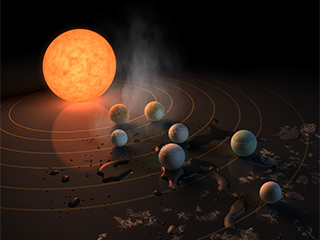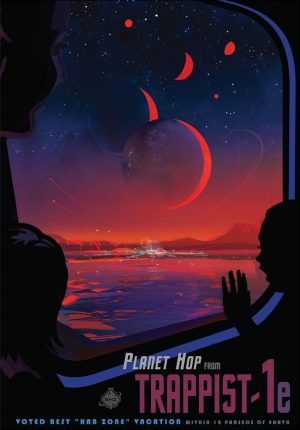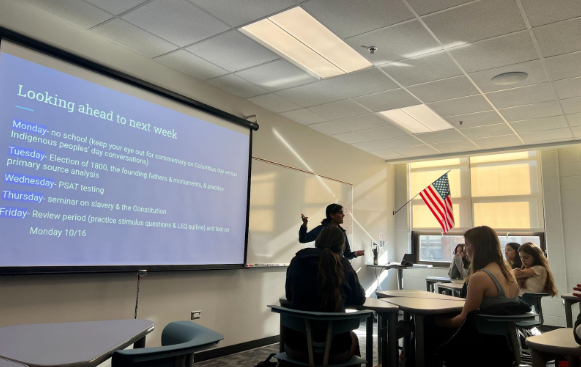Students react to NASA’s recent discovery of an exoplanet system

Courtesy of NASA Exoplanet Exploration
Since the system’s discovery, many artists have created possible visual representations. This illustration was created by visualization scientist Robert Hurst, a longtime collaborator with NASA.
On Wednesday, Feb. 22, NASA surprised people all over the world by announcing that their Spitzer Space Telescope discovered seven new planets in a system approximately 40 light-years away from Earth. That’s not all, however. In their official press release, NASA also suggested that three of these planets could be capable of supporting life.

An artist felt inspired by the possibility of life surviving on TRAPPIST-1 planets and decided to create a promotional travel poster.
The system is called TRAPPIST-1, in reference to the Transiting Planets and Planetesimals Small Telescope (TRAPPIST) in Chile that discovered three of the planets back in May 2016. Each planet, though, is yet to be named. For now, NASA is simply referring to them with letters.
“I think it’s amazing,” said Harsha Kaul, junior. “A new boundary has been broken in space exploration.”
Spitzer’s findings established a new record for greatest number of habitable-zone planets found around a single star outside our solar system. Since the system resides outside of our own, it’s categorized as exoplanetary. The star, classified as an ultra-cool dwarf, in the center of the TRAPPIST-1 system is different from the Sun because it’s much cooler, which would allow liquid water to survive on nearby planets.
NASA stated that they must continue to analyze the atmosphere and weather on the TRAPPIST-1 exoplanets before they can make any official claims about its habitability, but some students are still cautious of what this could mean for our future.
“It is definitely a potential idea for human immigration, but we have to establish the idea of saving energy and valuing the resources we have right now before even thinking about moving [to TRAPPIST-1],” said Tina Guo, senior captain of the Science Olympiad team, who has extensive involvement in the science community. “We don’t want to migrate and ruin another habitat.”
Despite some cautionary reactions, NASA has continued to post about the discovery to build excitement for further exploration. Scientific artists from various research centers have stepped in, making virtual-reality videos, fake vacation posters, and other illustrations.
Also, two days after the news was released, NASA asked Internet users to name the planets by tweeting on their official page. Since they discovered the system, it’s their responsibility to finalize the official names.
#7NamesFor7NewPlanets?
TRAPPIST-1b
TRAPPIST-1c
TRAPPIST-1d
TRAPPIST-1e
TRAPPIST-1f
TRAPPIST-1g
TRAPPIST-1h😉 https://t.co/QS80AnZ2Jg pic.twitter.com/gis6Ba7UBu
— NASA (@NASA) February 24, 2017
The tweet sparked an eclectic group of responses, ranging from “Snow White and the Seven Dwarfs” tributes to days of the week, which are actually already named for our solar system. It’s unlikely that NASA will use any of the names users suggested, but it certainly provided entertainment for many.
On Wednesday, March 2, NASA celebrated the 20th birthday of the Hubble Space Telescope’s Imaging Spectrograph. The Hubble Space Telescope has been and will be crucial in the continuous research of the planets’ surfaces, in addition to the Spitzer Telescope and Kepler Spacecraft. The amount of information that is yet to be found has left some feeling skeptical.
“I guess [the discovery] is kind of depressing because it’s so far away, so we might never get more information about the planets,” said Mr. Christopher McClain, physics teacher. “At the same time, I shouldn’t sell the scientists short. They’ll probably learn way more about it than I think they can.”
In 2018, NASA is launching the James Webb Space Telescope, which will provide the public with more-detailed information about the planets’ atmospheres and chemical makeup. Many students view new technological developments as the driving forces of modern astronomy because of the possibilities they present.
“To be honest, I wasn’t all that surprised [when the planets were discovered] considering the size of the universe and the technology we have nowadays,” Guo said. “It was only a matter of time before we spotted them in space.”
To learn more about TRAPPIST-1 and other exoplanetary systems, feel free to check out NASA’s exoplanet website.

Hannah Anderson is a senior whose second language is Internet. When she's not working on things for Devils' Advocate, she can usually be found blasting...

















